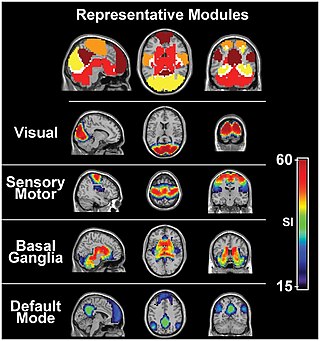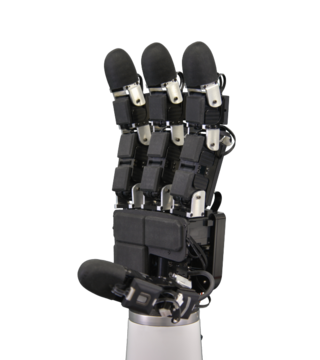
Perception is the organization, identification, and interpretation of sensory information in order to represent and understand the presented information or environment. All perception involves signals that go through the nervous system, which in turn result from physical or chemical stimulation of the sensory system. Vision involves light striking the retina of the eye; smell is mediated by odor molecules; and hearing involves pressure waves.
An illusion is a distortion of the senses, which can reveal how the mind normally organizes and interprets sensory stimulation. Although illusions distort the human perception of reality, they are generally shared by most people.
Bio-inspired computing, short for biologically inspired computing, is a field of study which seeks to solve computer science problems using models of biology. It relates to connectionism, social behavior, and emergence. Within computer science, bio-inspired computing relates to artificial intelligence and machine learning. Bio-inspired computing is a major subset of natural computation.

The sensory nervous system is a part of the nervous system responsible for processing sensory information. A sensory system consists of sensory neurons, neural pathways, and parts of the brain involved in sensory perception and interoception. Commonly recognized sensory systems are those for vision, hearing, touch, taste, smell, balance and visceral sensation. Sense organs are transducers that convert data from the outer physical world to the realm of the mind where people interpret the information, creating their perception of the world around them.
Stimulus modality, also called sensory modality, is one aspect of a stimulus or what is perceived after a stimulus. For example, the temperature modality is registered after heat or cold stimulate a receptor. Some sensory modalities include: light, sound, temperature, taste, pressure, and smell. The type and location of the sensory receptor activated by the stimulus plays the primary role in coding the sensation. All sensory modalities work together to heighten stimuli sensation when necessary.

Sensory neurons, also known as afferent neurons, are neurons in the nervous system, that convert a specific type of stimulus, via their receptors, into action potentials or graded receptor potentials. This process is called sensory transduction. The cell bodies of the sensory neurons are located in the dorsal ganglia of the spinal cord.
Voice leading is the linear progression of individual melodic lines and their interaction with one another to create harmonies, typically in accordance with the principles of common-practice harmony and counterpoint.
Sensory substitution is a change of the characteristics of one sensory modality into stimuli of another sensory modality.
In medicine and anatomy, the special senses are the senses that have specialized organs devoted to them:

An electronic nose is an electronic sensing device intended to detect odors or flavors. The expression "electronic sensing" refers to the capability of reproducing human senses using sensor arrays and pattern recognition systems.
The electronic tongue is an instrument that measures and compares tastes. As per the IUPAC technical report, an “electronic tongue” as analytical instrument including an array of non-selective chemical sensors with partial specificity to different solution components and an appropriate pattern recognition instrument, capable to recognize quantitative and qualitative compositions of simple and complex solutions
Computer audition (CA) or machine listening is the general field of study of algorithms and systems for audio interpretation by machines. Since the notion of what it means for a machine to "hear" is very broad and somewhat vague, computer audition attempts to bring together several disciplines that originally dealt with specific problems or had a concrete application in mind. The engineer Paris Smaragdis, interviewed in Technology Review, talks about these systems — "software that uses sound to locate people moving through rooms, monitor machinery for impending breakdowns, or activate traffic cameras to record accidents."
Haptic perception means literally the ability "to grasp something". Perception in this case is achieved through the active exploration of surfaces and objects by a moving subject, as opposed to passive contact by a static subject during tactile perception.

An odor or odour is caused by one or more volatilized chemical compounds that are generally found in low concentrations that humans and many animals can perceive via their sense of smell. An odor is also called a "smell" or a "scent", which can refer to either an unpleasant or a pleasant odor.
Extinction is a neurological disorder that impairs the ability to perceive multiple stimuli of the same type simultaneously. Extinction is usually caused by damage resulting in lesions on one side of the brain. Those who are affected by extinction have a lack of awareness in the contralesional side of space and a loss of exploratory search and other actions normally directed toward that side.
A sense is a biological system used by an organism for sensation, the process of gathering information about the surroundings through the detection of stimuli. Although, in some cultures, five human senses were traditionally identified as such, many more are now recognized. Senses used by non-human organisms are even greater in variety and number. During sensation, sense organs collect various stimuli for transduction, meaning transformation into a form that can be understood by the brain. Sensation and perception are fundamental to nearly every aspect of an organism's cognition, behavior and thought.

A tactile sensor is a device that measures information arising from physical interaction with its environment. Tactile sensors are generally modeled after the biological sense of cutaneous touch which is capable of detecting stimuli resulting from mechanical stimulation, temperature, and pain. Tactile sensors are used in robotics, computer hardware and security systems. A common application of tactile sensors is in touchscreen devices on mobile phones and computing.
Many types of sense loss occur due to a dysfunctional sensation process, whether it be ineffective receptors, nerve damage, or cerebral impairment. Unlike agnosia, these impairments are due to damages prior to the perception process.
Robotic sensing is a subarea of robotics science intended to provide sensing capabilities to robots. Robotic sensing provides robots with the ability to sense their environments and is typically used as feedback to enable robots to adjust their behavior based on sensed input. Robot sensing includes the ability to see, touch, hear and move and associated algorithms to process and make use of environmental feedback and sensory data. Robot sensing is important in applications such as vehicular automation, robotic prosthetics, and for industrial, medical, entertainment and educational robots.

Andranik Semovich Tangian (Melik-Tangyan) ; born March 29, 1952) is a Soviet Armenian-German mathematician, political economist and music theorist. He is professor of the Institute for Economics (ECON) of the Karlsruhe Institute of Technology.







